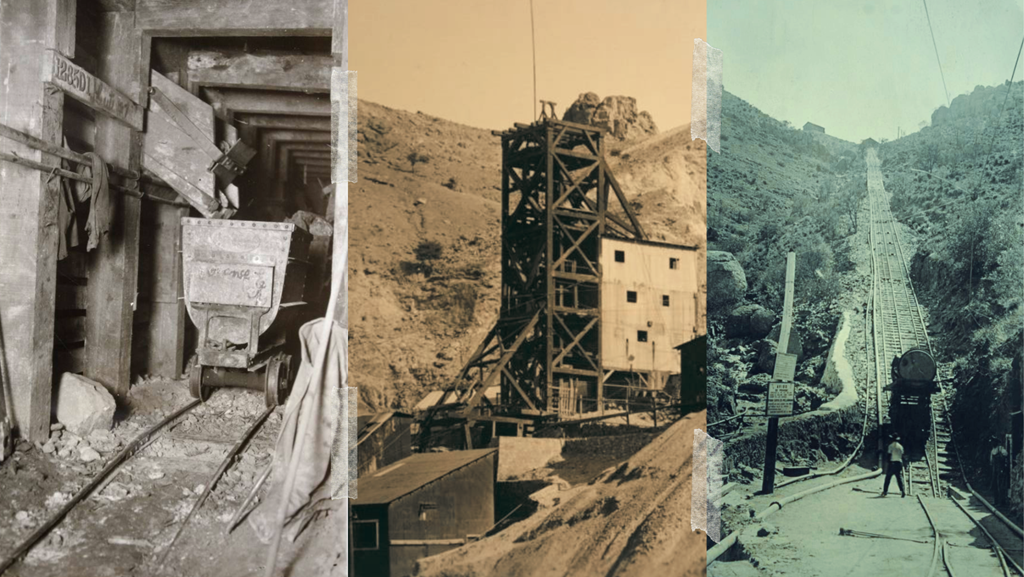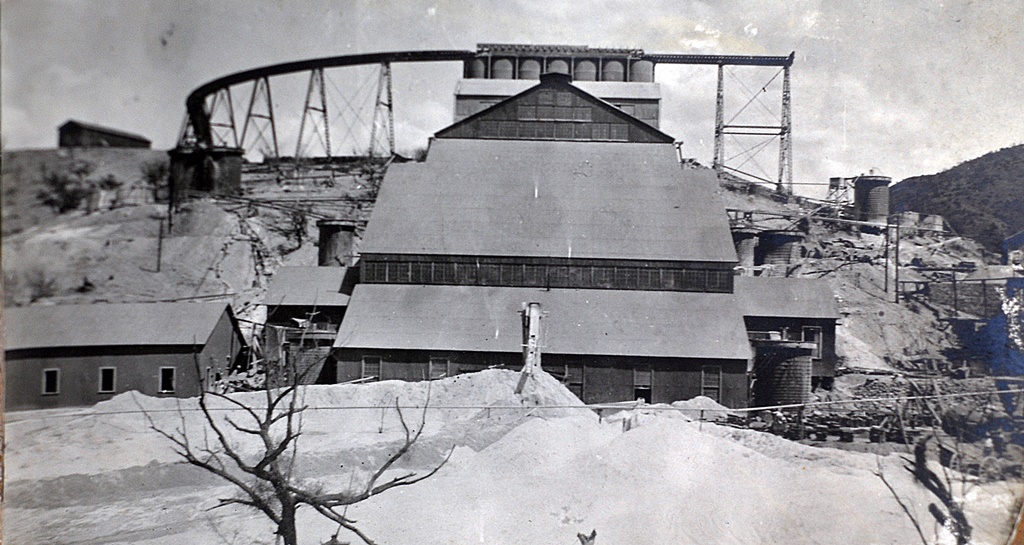
Moctezuma Copper Company—A Description of a Big Industry in Northern Sonora (1901)
20 de enero de 2023
By Allen T. Bird
During the several years now the public have known there was a big copper mine and reduction works over in the Moctezuma district of Sonora; but it has been so far away that but little information of what was going on over there came to the outside world, and from what has been made known, one can form no idea of the extent and magnitude of the mines and works and the importance of the great industry created near Nacozari by the Moctezuma Copper Co., one of the allied corporations owned and controlled by Phelps, Dodge & Co., of New York, who also controls the Copper Queen mines at Bisbee, Arizona, the big copper mines at Morenci, and one of the big copper mines at Globe.
When one makes the one-hundred-mile drive between Bisbee and the seat of the company’s operations and notes the tremendous amount of transportation stretched along the road between Naco and Nacozari, all engaged in conveying the commodities consumed by this great industry, and the product it exports, some conception arises in his mind that he is en route to a scene of colossal operation; but it is not until the place is visited and carefully inspected that any idea is reached of the extent and importance of this great camp.
The site of the company’s reduction works is at Placeritos, upon the Oposura river, about ninety miles from Naco, the sub-port near Bisbee where all traffic for that part of Sonora crosses the international line. The mines are about six miles away, and the ore is brought down by a narrow-gauge railway five and one-half miles long. At the upper terminus of the railway, there is an incline up which the cars are lifted and lowered by a tramway overcoming an elevation of 585 feet. The tramway is operated by gravity, the loaded car descending lifting the empty one. From the head of the incline, there are but a thousand feet of railway to the mouth of the upper tunnel, where are the ore bins, from which the ore is dumped into the cars, which are hauled by mules to the head of the incline, let down the tramway, coupled to a locomotive and hauled to the reduction works, the train running over a steel trestle work to the top of the ore bins, these at an elevation of forty feet above the rock crusher. These bins have a capacity of 2,400 tons—six days’ supply—and are made entirely of steel, being about thirty feet high, one hundred feet long, and fifteen feet in width.
From the foot of the incline, at the upper terminus of the railway, a tunnel is being run to cut the ore body at a depth of 585 feet below the present workings. The tunnel is now about four thousand feet in length and has about one thousand feet farther to run. From the upper tunnel, a shaft four hundred feet deep reaches down toward the line of the tunnel now penetrating the mountain. Further sinking in the shaft was stopped by water flowing in such quantities that heavy pumping machinery would be required to handle it.
A tunnel a mile long, it was found, would be less expensive. It will thoroughly drain the mine down to its own level and save the cost of the incline. Any ore below that level will have to be sunk for; but that is a consideration to be encountered years hence, for the ore now in sight above will keep the big plant busily engaged for many years.
At the mouth of the lower tunnel are a small air compressor to drive the Burleigh drills, a blower to send fresh air into the breast, and an electric light plant to light up the tunnel. Work therein is driven continuously, there being no stop. In going in the tunnel has a cut one body of very good ore, forty feet wide.

The ore body, as at the present development, is in the form of a crescent. The workings cut the crescent about its center, and the widest part thereof. At that point, it is one hundred and twenty feet in width. The country rock is porphyry, and the ledge matter is a porphyritic rock permeated with copper, iron, and sulfur. The entire ledge is stopped out, run to reduction works, concentrated, and smelted. There is no ore sorting and the rock reduced yields about seven percent copper. The rock is so compact that no timbering is necessary. In all, in the underground work of this great mine, the only timber employed has been the track sleepers.
The process the ore follows from the ledge to the finished product of copper bullion is decidedly interesting. That from the mine to the reduction works has been already described. From the ore bins at the reduction works, the ore passes two great rock crushers automatically fed. From the crushers, it passes through sizers, great revolving cylinders of iron, six feet in diameter and one hundred feet or more in length. The perpheries of the cylinders are studded with small holes which let through all the fine ore. The cylinders are slightly inclined, and as they revolve, the ore gradually travels down their length, streams of water washing out through the innumerable apertures the smallest particles of rock.
From the sizers, the ore goes to the jigs, where a large part of the concentrates, which escaped the sizers, are separated and taken directly to the furnace.
From the jigs, the ore passes to a batter of eight Huntington mills and two Cornish rolls. Passing the battery, it is concentrated by Frue vanners and Blake tables, there being twenty of the former and four of the latter.
Outside the smelter, before going into the furnace, concentrates are made into small round bricks, about three inches in diameter and two inches thick, a large machine shaping them with great rapidity. They are placed in movable racks and dried, and when ready, the racks are run to the charging floor, and the bricks go into the furnace with the usual fluxes. From the furnace, the molten metal goes to the converters, which burn out the sulfur and turn out the finished copper bullion.

The power used for driving nearly all the machinery about the reduction works comes from the powerhouse, a long brick building where are installed eight gas engines of forty horsepower capacity. Each engine runs a 260-volt dynamo, from which the power is transmitted by wires to electric motors, whenever wanted. The engines were made in Manchester, England, by Crossely Bros., and the dynamos are from the factory of the General Electric Co., in New York City.
The gas is manufactured in a gas plant, a short distance away from the powerhouse. Eight tons of coal are consumed daily, giving a power which would consume thirty tons daily if used under steam boilers.
The machine shops, carpenter shops, etc., are all of the very best descriptions. The buildings are all of brick or stone, with iron roofs, and inside are all sorts of machinery and appliances. Everything necessary to expedite work and minimize labor is employed. In the machine shop are two lathes, a planer, a boring machine, which can bore a hole any size through a six-foot casting, and a shaper. In the carpenter shop are a band saw, a mortiser, a planer with a tongue, and a grove attachment, a turning lathe, a power saw, etc., all run by an electric motor. There are also well-appointed assay offices, foundry, etc.
Upon the opposite side of the river from the works are the living quarters of those employed in and about the works, of whom there are about one thousand. Five long brick buildings, one story in height, arranged both sides of a long wide street, house a large part of the population. Further back is another row of similar structures devoted to the families of those American employees who have brought with them their lares and penates. At one end of the principal street, in one of the long buildings mentioned, is the company’s store, warehouse, and offices. In the store, a large force of clerks is engaged, and the place presents a very busy scene from six o’clock in the morning until eight o’clock at night.
As yet a large part of the work of the Moctezuma Copper Co. is in its constructive stage. Within a year all of the construction will be finished, the railway from Bisbee will be completed into the camp, and the operation of the company will come down to the mining and production of copper.
Everything is under the supervision of doctor L. D. Ricketts, general manager, who has been twelve years in the service of the company, serving the greater part of that time as consulting engineer, which post he still retains at the other plans mentioned in the beginning of this article.
Published on Cochise Review
Bisbee, Arizona, February 2, 1901
Cover Photos: Pilares de Nacozari scenes (ca. 1923) | Phelps Dodge Collection
© All Rights Reserved
